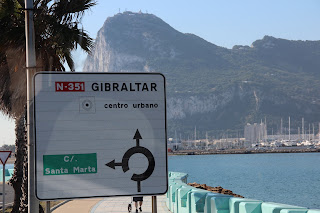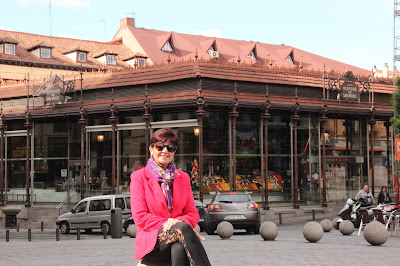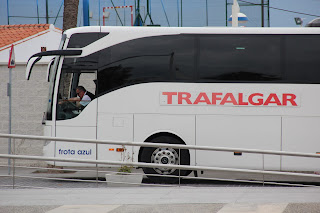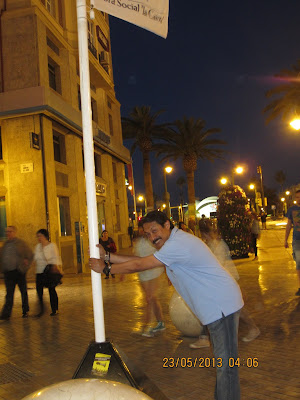ahhhh once you taste Spain, it is hard not to return, so we did. Needless to say, we had gotten used to the comforts, safety and dependability of Trafalgar Travels and Tours. Hence we chose to revisit Spain and experience Portugal with them.
MADRID
MADRID
Here we have Lanette eagerly waiting to get into the Reina Sofia Museum where one of my favourite Artist, Salvador Dali has a permanent display. (see www.museoreinasofia.es/en )
Our daily stop -
Located only 2 minutes from Plaza Mayor, the Mercado
San Miguel is a fabulous landmark where tourists mix with locals, tasting all
the delicacies in the different booths that operate there. From Jamon de
bellota, Cava (dry sparkling wine), to cheese, seafood and the creamy Bacalao.
Everything here is excellent. It is a must when you visit Marid. Submerge
yourself in this amazing environment. (www.mercadodessanmiguel.es)
El Rastro – this colourful street market is located in one of Madrid’s oldest working-class neighbourhoods, and has been operational for the last 100 years. Rastro means “trail” and refers to the animal innards and entrails that were dragged through the streets when it was the site of the main abattoir. Though it is best known as the world’s largest Flea Market, attracting 1000s in a day, Rastro also has dozens of shops selling clothes, furniture, antiques, food, leather, burners, shoes and upmarket items. (www.esmadrid.com/en/rastro-flea-market). We bought some very cool sunglasses, scarfs and wallets.
The Museo del Prado is the main Spanish
national art museum, located in central Madrid. It features one of the world's finest collections of
European art, from the 12th century to the early 19th century, based on the
former Spanish Royal Collection, and unquestionably the best single collection
of Spanish art. Founded as a museum of paintings and sculptures, it also contains important
collections of other types of works. A new, recently opened wing enlarged the
display area by about 400 paintings, and it is currently used mainly for
temporary expositions. El Prado is one of the most visited sites in the world,
and it is considered to be among the greatest museums of art. The large numbers
of works by Francisco de Goya, the
artist most extensively represented in the collection, and by Diego Velázquez, Titian, Peter Paul Rubens and Hieronymus Bosch are among the highlights of the collection.
(www.museodelprado.es/)
The Neptune Fountain is on Paseo del Prado. Under the orders of King Carlos III, sculptor Juan Pascual de Mena began to build this marble statue in 1780. In 1786 his disciple José Rodríguez finished off the project, which represents Neptune, God of the Sea, with a trident in one hand and a coiled snake in the other. The figure stands on a chariot, drawn by two sea horses and surrounded by dolphins. Near the Neptune Fountain, where the victories of Atlético de Madrid Football Club are celebrated, there are many of the city’s symbolic buildings, such as the Palace hotel, Villahermosa Palace, the Prado Museum, the Ritz hotel, the Congreso de los Diputados (House of Commons) and in the background, San Jerónimo el Real church
.
Of course being a Atletico Madrid fan, we celebrated with thousands when our team won the Copa del Rey 2013!http://www.youtube.com/watch?v=2ojEHpv9WDQ)
Leaving Madrid, we travelled
south, across the plains of La Mancha, and stopped at Puerto Lápice to visit
the inn where legendary Don Quixote received his knighthood. Venta del Quijote is where Don Quixote– the titular character of Miguel de Cervantes’ classic, Don Quixote– mistook the inn for a castle and was dubbed a “knight.” We stopped here to have sandwiches and taste the wines of the region.
UBEDAContinuing south into Andalucia, we then visited the UNESCO World Heritage town of Úbeda, walking around Vázquez de Molina Square, one of the best examples of Renaissance architecture in Spain. Exploring the town on our own free time, gave us ample opportunity to taste the local fare and shop.
BAEZA
Later in the afternoon, we visited
a traditional hacienda to see how olive oil is produced and tasted some for ourselves!
Extra Virgin Olive Oil never tasted so smooth before.
GRANADA
Citymar San Anton is a 4-star hotel with amazing views of the Sierra Nevada and Alhambra. This modern luxury hotel with an outdoor pool is close to the Citymar San Anton boasts with amazing views of the Sierra Nevada and Alhambra. The hotel offers an outdoor pool and is located close to the commercial and historical centre of Granada.
More importantly, this hotel has a view to die for. Our room afforded us the luxury of a 200degree view of the city. In one word – “Breathtaking!” Both in the day and at night. Lanette and I swore that if we ever visited Spain again, we would spend at least 2 more nights at San Anton. Kudos to Trafalgar for making this selection.
A visit to Granada would not be complete without a visit to a FLAMENCO show. Our hearts were pumped, and our senses stoked as these gorgeous women and men gyrated with passion.
The
Gypsies settled in Granada in the eighteenth century on the slopes of Cerro de
San Miguel on the edge of the Camino del Sacromonte, the old route of the
Guadix Muslims. The Sacromonte offers views of indescribable beauty: the towers
of the Alhambra, the white
slopes of the Albaycin,
the Valparaiso valley and the River Darro. The
caves of Sacromonte are grouped around ravines, forming what amounts to
streets. There are caves of several categories. The best known to visitors are
those devoted to Zambra: spacious, white and adorned with shiny copper pots.
The first historical documents known about The Alhambra
date from the 9th century and they refer to Sawwar ben
Hamdun who, in the year 889, had to seek refuge in the Alcazaba, a fortress, and had to repair it due to the civil
fights that were destroying the Caliphate of Cordoba, to which Granada then
belonged. This site subsequently started to be extended and populated, although
not yet as much as it would be later on, because the Ziri kings established
their residence on the hill of the Albaicin.
The castle of the Alhambra was added to the city's area within the ramparts in the 9th century, which implied that the castle became a military fortress with a view over the whole city. In spite of this, it was not until the arrival of the first king of the Nasrid dynasty, Mohammed ben Al-Hamar (Mohammed I, 1238-1273), in the 13th century, that the royal residence was established in the Alhambra. This event marked the beginning of the Alhambra's most glorious period.
The Alcazaba was reinforced and the Watch Tower (Torre de la Vela) and the Keep
(Torre del Homenaje) were built. Water was canalised from the river Darro,
warehouses and deposits were built and the palace and the ramparts were
started. These two elements were carried on by Mohammed II
(1273-1302) and Mohammed III (1302-1309), who apparently also
built public baths and the Mosque (Mezquita), on the site of
which the current Church of Saint Mary was later built.
The citadel boast some of the most magnificent gardens in the world. One would wonder how the government is able to afford such expanses that cost an equally exorbitant expense. So do visit and contribute to the economy, so that this beautiful city may continue to thrill future populations. http://www.alhambradegranada.org/en/info/historicalintroduction.asp
The Alhambra is located on a strategic point, with a view over the whole city and the meadow (la Vega), and this fact leads to belief that other buildings were already on that site before the Muslims arrived. The complex is surrounded by ramparts and has an irregular shape. It limits with the valley of the river Darro on its northern side, with the valley of al-Sabika on its southern side and with the street Cuesta del Rey Chico on the eastern side. The Cuesta del Rey Chico is also the border between the neighbourhood of the Albaicin and the gardens of the Generalife, located on top of the Hill of the Sun (Cerro del Sol).
Malaga
Málaga (Spanish pronunciation: [ˈmalaɣa]) is a city and a municipality, capital of the Province of Málaga, in the Autonomous Community of Andalusia, Spain.

With a population of 569,600 in 2012, it is the second most populous city of Andalusia and the sixth largest in Spain. The southernmost large city in Europe, it lies on the Costa del Sol (Coast of the Sun) of the Mediterranean, about 100 km (62.14 mi) east of the Strait of Gibraltar and about 130 km (80.78 mi) north of Africa.
The typical vegetation of Andalusia is Mediterranean woodland,
characterized by leafy
xerophilic
perennials,
adapted to the long, dry summers. The dominant species of the climax
community is the Holly Oak (Quercus ilex).
Also abundant are Cork Oak (Quercus suber),
various pines,
and Spanish Fir (Abies pinsapo). Due to cultivation, olive (Olea europaea)
and almond
(Prunus dulcis) trees also abound. But nothing beats the beautiful
Purple Jacaranda trees that line all the main avenues of Malaga and indeed most
of Andalusia.
Málaga's history spans about 2,800 years, making it one of the oldest cities in the world. It was founded by the Phoenicians as Malaka about 770 BC, and from the 6th century BC was under the hegemony of Ancient Carthage. Then from 218 BC it was ruled by the Roman Republic and later the Roman Empire as Malaca (Latin). After the fall of the empire it was under Islamic domination as Mālaqah (مالقة) for 800 years, but in 1487 it again came under Christian rule in the Reconquista. The archaeological remains and monuments from the Phoenician, Roman, Arabic and Christian eras make the historic center of the city an "open museum", displaying its rich history of more than 3,000 years.
This
important cultural infrastructure and the rich artistic heritage have
culminated in the nomination of Málaga as a candidate for the 2016 European Capital of Culture. The
internationally acclaimed painter and sculptor Pablo Picasso
and actor Antonio Banderas were born in Málaga. The
magnum opus of Cuban composer Ernesto Lecuona, "Malagueña", is named for the music of this
region of Spain.
A beautiful view of the port and marina of Malaga, where super cruise liners call before heading out on their long voyages. The greenery at bottom right is their "Central Park" which shades the many tourist areas.
Long avenues like these are flanked by upmarket shops that include Prada, Hermes, Loewe, Llandro and many others. We had a delicious time shopping for perfumes amidst tasting the local delicacies. I think Lanette alone might have consumed 3-4 punnets of cherries and strawberries.
MIJAS
Mijas is a lovely Andalusian town on the Costa del Sol, not far from
Fuengirola. With 12 kilometres of coastline, including the La Cala de Mijas
beach resort with its European blue flag, it is the perfect family friendly
holiday destination for a spot of Mediterranean sun.
Aside from relaxing on La Cala de
Mijas or one of the other beaches along Mijas's 12km of coastline, you can
climb up to the white-washed village of Mijas Pueblo on the mountainside for
stunning views across the Costa del Sol, Gibraltar, the Atlas Mountains and
over to the African coastline.
Mijas Pueblo is also the place to
head to take a look at the traditional bull ring or to take a donkey trip on a
short tour around the area. There are also at least seven golf courses in the
area surrounding Mijas (with several more under construction). The streets of
Mijas are very tourist friendly, and are full of independent shops selling hand
made local crafts and products.
Go past the tacky souvenir shops that first greet you upon your arrival in Mijas and explore the many side streets in Mijas. You'll find many upscale shops that sell high quality leather goods, clothing, ceramics, olive oil products and jewelry. The leather goods are inexpensive. Mijas has a number of official Lladro retailers, so if that is your thing, you'll enjoy looking at all the figurines. Look for the best stores in the narrow streets off of the busiest streets in Mijas.
Here we see Lanette very pleased with my gift of a beautiful hand stitched blood red soft leather jacket. She was feeling a little cold, so I thought it would warm her up.
Costa Del Sol
After a heady day on the hills of Mijas, we returned back to sea level and headed for the beaches of Costa Del Sol to share a special meal at one of Trafalgar's secrets.
http://www.visitcostadelsol.com/discover-costa-del-sol
There was entertainment by this sprightly gentleman who sang some of the more popular Spanish numbers which always ended with a howl done with a drunken stupor. His antics were most appreciated, especially after most of us had downed 3 - 4 glasses of good quality wine.
The main course of Cod baked in salt was absolutely divine, especially when it was served by the owner of the restaurant.
And when it came time to sing for a birthday celebrant, she sportingly sang and danced with our tour director Maria. Needless to say, we all left with a high.
Lanette and our Tour Director Maria with The Rock of Gibraltar in the background.


The view from the balcony of our room on the 7th floor of the Hotel Don Curro.

Gibraltar is a British Overseas Territory
located on the southern end of the Iberian Peninsula at the entrance of the Mediterranean. It has an area of 6.8 square kilometres
(2.6 sq mi) and a northern border with Andalusia, Spain. The Rock of Gibraltar is the only landmark of the region. At its
foot is the densely populated city area, home to almost 30,000 Gibraltarians and other
nationalities.
The sovereignty of
Gibraltar is a major point of contention in Anglo-Spanish relations as
Spain asserts a claim to the territory. Gibraltarians rejected proposals for Spanish
sovereignty in a 1967 referendum
and again in 2002.
Under the Gibraltar constitution of 2006,
Gibraltar governs its own affairs, though some powers, such as defence and
foreign relations, remain the responsibility of the UK Government.

St
Michael's Cave (Spanish: Cueva de San Miguel) is the name given to a network of limestone caves located in the Upper Rock Nature Reserve
of Gibraltar, at a height of over 300 metres above sea level. According to Alonso Hernández del Portillo,
the first historian of Gibraltar, its name is derived from a similar grotto
in Monte Gargano near the Sanctuary of Monte Sant'Angelo
in Apulia, Italy, where the archangel Michael is said
to have appeared.
Most of the Rock's upper area is covered by a nature reserve which is home to around 230 Barbary Macaques – often mistakenly called "apes"–that are the only wild monkeys found in Europe.[40] This species, known scientifically as Macaca sylvanus, is listed as endangered by the IUCN Red List and is declining. Three quarters of the world population live in the Middle Atlas mountains of Morocco. Recent genetic studies and historical documents point to their presence on the Rock before its capture by the British. A superstition analogous to that of the ravens at the Tower of London states that if the monkeys ever leave, so will the British. In 1944 British Prime Minister Winston Churchill, was so concerned about the dwindling monkey population that he sent a message to the Colonial Secretary requesting that something be done about the situation.[41]
Cute they may look, however one cannot but think that these buggers were trained to pander to the tourists. Do be careful because once you let your guard down, these monkeys are likely to snatch your glasses, bags, cameras etc. They are the same everywhere, Bali, Bangkok, Singapore....monkeys are curious and territorial, and anything is fair game to them.
The main square on Gibraltar which is surrounded by shops of every conceivable imagination. All are Duty Free, hence liqueur and jewellery abound. Of the over 30 restaurants on the square, half serve Fish and Chips and all claim to be the Original English recipe.
 The shopping just outside our hotel (in the background) was just too inviting. Best of all was the local market 5 minutes away from the Don Curro Hotel, which sold fresh fruits. Needless to say...we stuffed our faces with Cherries, Strawberries, Oranges, Apples, dates and nuts. The flowers were in full bloom all over Malaga. This bush matched Lanette's outfit for the day.
The shopping just outside our hotel (in the background) was just too inviting. Best of all was the local market 5 minutes away from the Don Curro Hotel, which sold fresh fruits. Needless to say...we stuffed our faces with Cherries, Strawberries, Oranges, Apples, dates and nuts. The flowers were in full bloom all over Malaga. This bush matched Lanette's outfit for the day. Horse drawn carriages waiting to lure tourists. Here we chanced upon a "Carriage Wash Corner" like our car wash.
Horse drawn carriages waiting to lure tourists. Here we chanced upon a "Carriage Wash Corner" like our car wash.
We were very lucky indeed to witness one of the local cultural festivals which celebrated the senior citizens. Each region sent representatives to set up booths to advertise their local ware, showcase their dance, costumes and culture.
Here we see young tourists from various parts of Spain waiting to be given a tour of Malaga. I wondered aloud if this was their form of costume. My enquiry got lost in translation.
As in most of Europe, there were many buskers throughout Spain. Here a pair create mystery with the Levitation Trick. Not an easy one to get into position publicly. Nearly everyone wonder how this was done.
RONDA
Ronda is a town in Malaga in Spain. Set in and around a deep gorge spanned by an impressive
bridge, the relaxing atmosphere here is a great break from some of the more
tourist-ridden places on the south coast of Spain, however it can still be
packed with day-trippers from the Costa del Sol, especially during the peak
summer months.
In the
fashion world, Italian designer Giorgio Armani specially designed the
bullfighting costume called ‘Goyesco’ for famed bullfighter Cayetano Rivera
Ordóñez on the occasion of the ‘Corrida Goyesca’ that took place on
September 6, 2009, in Ronda. Cayetano's suit of lights was in the Goyaesque
style, comprising a jacket, trousers and cloak in techno-satin. The three
pieces are embroidered with sequins, small glitter stones and thread, all
matching the colour of the background fabric.
Ronda was
heavily affected by the Spanish Civil War,
after which much of the population emigrated elsewhere. The famous scene in
Chapter 10 of Hemingway's "For Whom the Bell
Tolls", describing the 1936 execution of Fascist sympathisers
in a (fictional) village who are thrown off a cliff, is considered to be modeled
on actual events at the time in Ronda.
Around the
city are remains of prehistoric settlements dating to the Neolithic Age, including the rock paintings of Cueva de la Pileta.
Ronda was however first settled by the early Celts, who, in the 6th century BC, called it Arunda.
Later Phoenician settlers established themselves
nearby to found Acinipo, known locally as Ronda la Vieja,
Arunda or Old Ronda. The current Ronda is however of Roman origins,[1] having been founded as a
fortified post in the Second Punic War,
by Scipio Africanus.
Ronda received the title of city at the time of Julius Caesar.
Chilling out with beers and pigeons on cobbled streets in Ronda.
Jamon hanging at every restaurant. Surely not a place for Halal needs, but meat lovers haven.
Fooling around outside our hotel. Placed a Singapore flag on main street to claim it for The Lee Family...NOT!
Our included dinner at Hotel Don Curro.....2 words...............absolutely delicious! Endless bottles of wine courtesy of Trafalgar.




























































